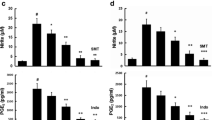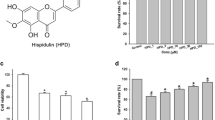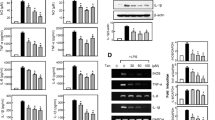Abstract
Microglia, resident macrophages of the central nervous system (CNS), is responsible for immune responses and homeostasis of the CNS. Microglia plays a complex role in neuroinflammation, which has been implicated in neurodegenerative diseases such as Alzheimer’s disease and Parkinson’s disease. Therefore, therapeutic agents that suppress the microglia-mediated inflammatory response could potentially be used in the prevention or treatment of neurodegenerative diseases. Vanillin, a primary component of vanilla bean extract, has anti-inflammatory, anticancer, and antitumor properties. However, the effects of vanillin on the anti-neuroinflammatory responses of microglial cells are still poorly understood. In this study, we investigated the mechanism by which vanillin induces anti-neuroinflammatory responses in lipopolysaccharide (LPS)-stimulated BV-2 microglial cells. We found that vanillin significantly decreased the production of nitric oxide and pro-inflammatory cytokines, including interleukin (IL)-1β, tumor necrosis factor-α (TNF-α), and interleukin-6 (IL-6). Vanillin also reduced the protein levels of inducible nitric oxide synthase (iNOS) and cyclooxygenase-2 (COX-2), as well as the mRNA expression levels of IL-1β, TNF-α, and IL-6. Moreover, vanillin inhibited the phosphorylation of mitogen-activated protein kinases (MAPKs) and nuclear factor (NF)-κB. Collectively, these results suggest that vanillin has anti-neuroinflammatory properties and may act as a natural therapeutic agent for neuroinflammatory diseases.





Similar content being viewed by others
References
Chen, L., Mo, M., Li, G., Cen, L., Wei, L., Xiao, Y., Chen, X., Li, S., Yang, X., Qu, S., & Xu, P. (2016). The biomarkers of immune dysregulation and inflammation response in Parkinson disease. Translational Neurodegeneration, 5(1), 16.
Elsherbiny, N. M., Younis, N. N., Shaheen, M. A., & Elseweidy, M. M. (2016). The synergistic effect between vanillin and doxorubicin in ehrlich ascites carcinoma solid tumor and MCF-7 human breast cancer cell line. Pathology, Research and Practice, 212(9), 767–777.
Takada, L. T. (2017). Innate immunity and inflammation in Alzheimer s disease pathogenesis. Arquivos de Neuro-Psiquiatria, 75(9), 607–608.
Dong, Y., Xu, M., Kalueff, A. V., & Song, C. (2017). Dietary eicosapentaenoic acid normalizes hippocampal omega-3 and 6 polyunsaturated fatty acid profile, attenuates glial activation and regulates BDNF function in a rodent model of neuroinflammation induced by central interleukin-1beta administration. European Journal of Nutrition, 57(5), 1781–1791.
Jeitner, T. M., Kalogiannis, M., Krasnikov, B. F., Gomolin, I., Peltier, M. R., & Moran, G. R. (2016). Linking inflammation and Parkinson disease: hypochlorous acid generates parkinsonian poisons. Toxicological Sciences, 153(2), 410.
Madeira, M. H., Boia, R., Ambrosio, A. F., & Santiago, A. R. (2017). Having a coffee break: the impact of caffeine consumption on microglia-mediated inflammation in neurodegenerative diseases. Mediators of Inflammation, 2017, 4761081.
Dulla, Y. A., Kurauchi, Y., Hisatsune, A., Seki, T., Shudo, K., & Katsuki, H. (2016). Regulatory mechanisms of vitamin D3 on production of nitric oxide and pro-inflammatory cytokines in microglial BV-2 cells. Neurochemical Research, 41(11), 2848–2858.
Han, B. H., Lee, Y. J., Yoon, J. J., Choi, E. S., Namgung, S., Jin, X. J., Jeong, D. H., Kang, D. G., & Lee, H. S. (2017). Hwangryunhaedoktang exerts anti-inflammation on LPS-induced NO production by suppressing MAPK and NF- kappaB activation in RAW264.7 macrophages. J Integrative Medicine, 15(4), 326–336.
Kim, D. H., Kim, M. E., & Lee, J. S. (2015). Inhibitory effects of extract from G. lanceolata on LPS-induced production of nitric oxide and IL-1beta via down-regulation of MAPK in macrophages. Applied Biochemistry and Biotechnology, 175(2), 657–665.
Deng, G., He, H., Chen, Z., OuYang, L., Xiao, X., Ge, J., Xiang, B., Jiang, S., & Cheng, S. (2017). Lianqinjiedu decoction attenuates LPS-induced inflammation and acute lung injury in rats via TLR4/NF-kappa B pathway. Biomedicine & Pharmacotherapy, 96, 148–152.
Abhimannue, A. P., Mohan, M. C., & Prakash Kumar B. (2016). Inhibition of tumor necrosis factor-alpha and interleukin-1beta production in lipopolysaccharide-stimulated monocytes by methanolic extract of Elephantopus scaber Linn and Identification of bioactive components. Applied Biochemistry and Biotechnology, 179(3), 427–443.
Srinual, S., Chanvorachote, P., & Pongrakhananon, V. (2017). Suppression of cancer stem-like phenotypes in NCI-H460 lung cancer cells by vanillin through an Akt-dependent pathway. International Journal of Oncology, 50(4), 1341–1351.
Al Asmari, A., Al Shahrani, H., Al Masri, N., Al Faraidi, A., Elfaki, I., & Arshaduddin, M. (2016). Vanillin abrogates ethanol induced gastric injury in rats via modulation of gastric secretion, oxidative stress and inflammation. Toxicology Reports, 3, 105–113.
Liu, J., & Mori, A. (1993). Antioxidant and pro-oxidant activities of p-hydroxybenzyl alcohol and vanillin: effects on free radicals, brain peroxidation and degradation of benzoate, deoxyribose, amino acids and DNA. Neuropharmacology, 32(7), 659–669.
Rehman, M. U., Tahir, M., Khan, A. Q., Khan, R., Oday, O. H., Lateef, A., Hassan, S. K., Rashid, S., Ali, N., Zeeshan, M., & Sultana, S. (2014). D-limonene suppresses doxorubicin-induced oxidative stress and inflammation via repression of COX-2, iNOS, and NFkappaB in kidneys of Wistar rats. Experimental Biology and Medicine (Maywood, N.J.), 239(4), 465–476.
Zhao, D., Kwon, S. H., Chun, Y. S., Gu, M. Y., & Yang, H. O. (2017). Anti-neuroinflammatory effects of fucoxanthin via inhibition of Akt/NF-kappaB and MAPKs/AP-1 pathways and activation of PKA/CREB pathway in lipopolysaccharide-activated BV-2 microglial cells. Neurochemical Research, 42(2), 667–677.
Park, S. Y., Jin, M. L., Kang, N. J., Park, G., & Choi, Y. W. (2017). Anti-inflammatory effects of novel polygonum multiflorum compound via inhibiting NF-kappaB/MAPK and upregulating the Nrf2 pathways in LPS-stimulated microglia. Neuroscience Letters, 651, 43–51.
Phull, A. R., Eo, S. H., & Kim, S. J. (2017). Oleanolic acid (OA) regulates inflammation and cellular dedifferentiation of chondrocytes via MAPK signaling pathways. Cellular and Molecular Biology (Noisy-le-Grand, France), 63(3), 12–17.
Chan, C. K., Tan, L. T., Andy, S. N., Kamarudin, M. N. A., Goh, B. H., & Kadir, H. A. (2017). Anti-neuroinflammatory activity of elephantopus scaber L. via activation of Nrf2/HO-1 signaling and inhibition of p38 MAPK pathway in LPS-induced microglia BV-2 cells. Frontiers in Pharmacology, 8, 397.
Chang, C., Wang, K., Zhou, S. N., Wang, X. D., & Wu, J. E. (2017). Protective effect of Saccharomyces boulardii on deoxynivalenol-induced injury of porcine macrophage via attenuating p38 MAPK signal pathway. Applied Biochemistry and Biotechnology, 182(1), 411–427.
Cantacorps, L., Alfonso-Loeches, S., Moscoso-Castro, M., Cuitavi, J., Gracia-Rubio, I., Lopez-Arnau, R., Escubedo, E., Guerri, C., & Valverde, O. (2017). Maternal alcohol binge drinking induces persistent neuroinflammation associated with myelin damage and behavioural dysfunctions in offspring mice. Neuropharmacology, 123, 368–384.
Karthikeyan, A., Patnala, R., Jadhav, S. P., Eng-Ang, L., & Dheen, S. T. (2016). MicroRNAs: key players in microglia and astrocyte mediated inflammation in CNS pathologies. Current Medicinal Chemistry, 23(30), 3528–3546.
Funding
This research was supported by a grant from Marine Biotechnology Program (PJT200669) funded by the Ministry of Oceans and Fisheries and the National Research Foundation of Korea (NRF) grant funded by the Korea government (NRF-2017R1D1A1B03034673), Korea.
Author information
Authors and Affiliations
Corresponding authors
Ethics declarations
Conflict of Interest
The authors declare that they have no conflict of interest.
Rights and permissions
About this article
Cite this article
Kim, M.E., Na, J.Y., Park, YD. et al. Anti-Neuroinflammatory Effects of Vanillin Through the Regulation of Inflammatory Factors and NF-κB Signaling in LPS-Stimulated Microglia. Appl Biochem Biotechnol 187, 884–893 (2019). https://doi.org/10.1007/s12010-018-2857-5
Received:
Accepted:
Published:
Issue Date:
DOI: https://doi.org/10.1007/s12010-018-2857-5




